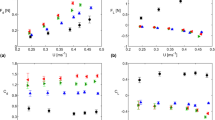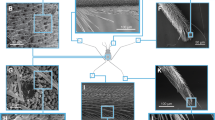Abstract
Water striders Gerridae are insects of characteristic length 1 cm and weight 10 dynes that reside on the surface of ponds, rivers, and the open ocean1,2,3,4. Their weight is supported by the surface tension force generated by curvature of the free surface5,6, and they propel themselves by driving their central pair of hydrophobic legs in a sculling motion7,8. Previous investigators have assumed that the hydrodynamic propulsion of the water strider relies on momentum transfer by surface waves1,9,10. This assumption leads to Denny's paradox11: infant water striders, whose legs are too slow to generate waves, should be incapable of propelling themselves along the surface. We here resolve this paradox through reporting the results of high-speed video and particle-tracking studies. Experiments reveal that the strider transfers momentum to the underlying fluid not primarily through capillary waves, but rather through hemispherical vortices shed by its driving legs. This insight guided us in constructing a self-contained mechanical water strider whose means of propulsion is analogous to that of its natural counterpart.
This is a preview of subscription content, access via your institution
Access options
Subscribe to this journal
Receive 51 print issues and online access
$199.00 per year
only $3.90 per issue
Buy this article
- Purchase on Springer Link
- Instant access to full article PDF
Prices may be subject to local taxes which are calculated during checkout




Similar content being viewed by others
References
Andersen, N. M. A comparative study of locomotion on the water surface in semiaquatic bugs (Insecta, Hemiptera, Gerromorpha). Vidensk. Meddr. Dansk. Naturh. Foren. 139, 337–396 (1976)
Brinkhurst, R. O. Studies on the functional morphology of Gerris najas degeer (Hem. Het. Gerridae). Proc. Zool. Soc. Lond. 133, 531–559 (1960)
Murphey, R. K. A: Motor control of orientation to prey by the water strider Gerris remigis. Z. Vergl. Physiol. 72, 150–167 (1971)
Wilcox, R. S. Sex discrimination in Gerris remigis: Role of a surface wave signal. Science 206, 1325–1327 (1979)
Baudoin, R. La physico-chimie des surfaces dans la vie des arthropodes aeriens des miroirs d'eau, des rivages marins et lacustres et de la zone intercotidale. Bull. Biol. Fr. Belg. 89, 16–164 (1955)
Keller, J. B. Surface tension force on a partly submerged body. Phys. Fluids 10, 3009–3010 (1998)
Darnhofer-Demar, B. Zur Fortbewegung des Wasserlaufers Gerris lacustris L. auf des Wasseroberflache. Zool. Anz. Suppl. 32, 430–439 (1969)
Bowdan, E. Walking and rowing in the water strider, Gerris remigis. J. Comp. Physiol. 123, 43–49 (1978)
Denny, M. W. Air and Water: The Biology and Physics of Life's Media (Princeton Univ. Press, Princeton, NJ, 1993)
Sun, S. M. & Keller, J. B. Capillary-gravity wave drag. Phys. Fluids 13, 2146–2151 (2001)
Suter, R. B., Rosenberg, O., Loeb, S., Wildman, H. & Long, J. H. Locomotion on the water surface: propulsive mechanisms of the fisher spider Dolomedes triton. J. Exp. Biol. 200, 2523–2538 (1997)
Childress, S. Mechanics of Swimming and Flying (Cambridge Univ. Press, Cambridge, UK, 1981)
Vogel, S. Life's Devices (Princeton Univ. Press, Princeton, NJ, 1988)
Dickinson, M. H. et al. How animals move: an integrated view. Science 288, 100–106 (2000)
Rayner, J. M. V., Jones, G. & Thomas, A. Vortex flow visualizations reveal change in upstroke function with flight speed in bats. Nature 321, 162–164 (1986)
Ellington, C. P. Oxygen consumption of bumblebees in forward flight. Nature 347, 472–473 (1990)
Vogel, S. Life in Moving Fluids (Princeton Univ. Press, Princeton, NJ, 1994)
Glasheen, J. W. & McMahon, T. A. A hydrodynamic model of locomotion in the Basilisk Lizard. Nature 380, 340–342 (1996)
de Gennes, P.-G., Brochard-Wyart, F. & Quere, D. Gouttes, Boules, Perles et Ondes (Belin, Collection Echelles, Paris, 2002)
Tseng, M. & Rowe, L. Sexual dimorphism and allometry in the giant water strider Gigantometra gigas. Can. J. Zool. 77, 923–929 (1999)
Lamb, H. Hydrodynamics, 6th edn (Cambridge Univ. Press, Cambridge, 1932)
Schooley, A. H. Profiles of wind-created water waves in the capillary-gravity transition region. J. Mar. Res. 16, 100–108 (1958)
Suter, R. B. & Wildman, H. Locomotion on the water surface: hydrodynamic constraints on rowing velocity require a gait change. J. Exp. Biol. 202, 2771–2785 (1999)
Matsuda, K., Watanabe, S. & Eiju, T. Real-time measurement of large liquid surface deformation using a holographic shearing interferometer. Appl. Opt. 24, 4443–4447 (1985)
Starr, V. P. Momentum and energy integrals for gravity waves of finite height. J. Mar. Res. 6, 175–193 (1947)
Andersen, N. M. The Semiaquatic Bugs (Hemiptera, Gerromorpha): Phylogeny, Adaptations, Biogeography and Classification (Scandinavian Science, Klampenborg, 1982)
Hungerford, H. B. & Matsuda, R. Keys to subfamilies, tribes, genera and subgenera of the Gerridae of the world. Kans. Univ. Sci. Bull. 41 (1960)
Henry, T. J. & Froeschner, R. C. (eds) Catalog of the Heteroptera, of True Bugs, of Canada and the Continental United States (E. J. Brill, Leiden, 1998)
Cobben, R. H. The Hemiptera of the Netherlands. Stud. Fauna Curacao Caribb. Islands 11, 1–34 (1960)
Scriven, L. E. & Sternling, C. V. The Marangoni effects. Nature 187, 186–188 (1970)
Acknowledgements
We thank A. Chau for preparing Fig. 2, M. Hancock, M. Shelley and R. Rosales for discussions, and MIT's Edgerton Center for lending us their high-speed video equipment. J.W.M.B. gratefully acknowledges the financial support of the NSF.
Author information
Authors and Affiliations
Corresponding author
Ethics declarations
Competing interests
The authors declare that they have no competing financial interests.
Rights and permissions
About this article
Cite this article
Hu, D., Chan, B. & Bush, J. The hydrodynamics of water strider locomotion. Nature 424, 663–666 (2003). https://doi.org/10.1038/nature01793
Received:
Accepted:
Issue Date:
DOI: https://doi.org/10.1038/nature01793
This article is cited by
-
Research Progress on Bionic Water Strider Robots
Journal of Bionic Engineering (2024)
-
Scale dependence in hydrodynamic regime for jumping on water
Nature Communications (2023)
-
Recurrent graph optimal transport for learning 3D flow motion in particle tracking
Nature Machine Intelligence (2023)
-
Droplet attraction and coalescence mechanism on textured oil-impregnated surfaces
Nature Communications (2023)
-
Honeybee comb-inspired stiffness gradient-amplified catapult for solid particle repellency
Nature Nanotechnology (2023)
Comments
By submitting a comment you agree to abide by our Terms and Community Guidelines. If you find something abusive or that does not comply with our terms or guidelines please flag it as inappropriate.



